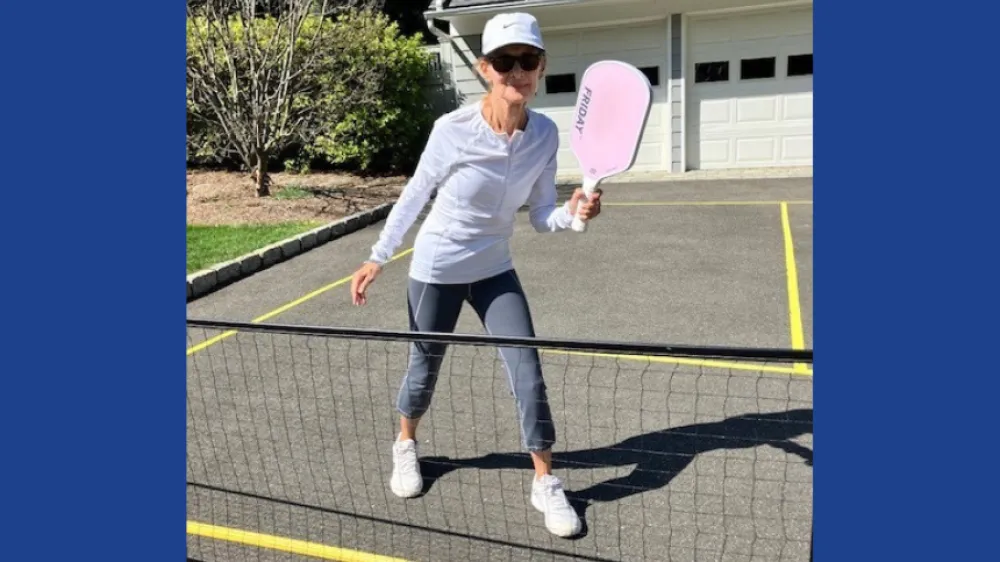Providing your location allows us to show you nearby locations and doctors.
From pain to pickleball: spine surgery for spinal stenosis gives personal trainer her life back

09/08/2024
A dedicated personal trainer, pickleball fanatic and power walker finally got relief from terrible pain after spine surgery for spinal stenosis.
Fitness isn’t just a profession for Shelley Kaiser — it’s her way of life. For 30 years, she has inspired her clients to meet their fitness goals, while pursuing her athletic passions. But when debilitating pain in her right calf threatened to sideline her, Shelley knew she had to find a solution, even if it meant having spine surgery.
Learn more about back and spine surgery at the Nuvance Health Neuroscience Institute.
Smiling through the pain caused by spinal stenosis
For two years, Shelley, a 74-year-old from Westport, Conn., persevered through unrelenting pain in her right calf. As a fitness professional, she knew it was nerve pain likely caused by a problem in her lumbar spine (lower back).
Sure enough, Shelley learned she had spinal stenosis.
Spinal stenosis is common and occurs when the spaces within the spine narrow, leading to increased pressure on the spinal cord and nerve roots. This narrowing typically develops over time and can affect different parts of the spine.
For Shelley, the stenosis was compressing a nerve in the lumbar spine at vertebrae L4/L5, causing persistent pain in her calf.
“Standing for long periods or slowly walking made the pain worse, and that’s how I spent most of the day when I trained clients,” Shelley said.
Shelley is a “pickleball fanatic” and couldn’t bear to stay off the court. While the sport brought her joy, the pain took a toll.
“I put on a happy face, but felt exhausted, emotionally and physically, at the end of each day. It affected my mood, too — I felt crabby,” said Shelley, which is out of character for the upbeat, vibrant power walker.
She sought relief through corticosteroid injections, which initially helped. However, as time went on, the injections became less effective.
Related content: Know when to get spine treatment for back and neck pain
Spine surgery for spinal stenosis
When the pain became too much to bear, Shelley decided it was time for surgery. Initially, she considered staying local for spine surgery, because her husband, Ben, had a successful procedure with Dr. Scott Sanderson, chief of neurosurgery at Danbury Hospital. But at the suggestion of a friend, she opted for surgery in New York City. Unfortunately, the outcome was disappointing — the pain in her calf persisted.
“So, I went to see Dr. Sanderson,” Shelley said.
“Like many people in their 70s, Shelley had arthritis and degeneration throughout her spine and multiple pinched nerves that were not causing symptoms,” Dr. Sanderson said. “In Shelley’s case, the imaging results didn’t match her symptoms because the worst-looking part of her spine wasn’t the cause of her pain.”
After a detailed patient history, nerve function test and physical exam, Dr. Sanderson identified the specific nerve causing Shelley’s pain.
“When it comes to complex degenerative spine conditions, MRI results aren’t enough to recommend treatment. It’s important to have a comprehensive anatomical understanding of the nervous system and the patient’s medical history to assess the best possible treatment,” Dr. Sanderson said.
Related article: Do these five things before your first visit with a surgeon for spine pain
Laminectomy spine surgery relieves pain caused by spinal stenosis
In July 2022, Shelley underwent a second surgery at Danbury Hospital with Dr. Sanderson. He performed a laminectomy through a small incision without needing to place any hardware in Shelley’s spine.
Laminectomy is an effective procedure for treating spinal stenosis. The surgeon removes some or all of the lamina — the back portion of the vertebra that covers the spinal canal — to relieve pressure on the spinal cord and nerve bundle. Most people experience significant pain relief after the surgery because the nerve is not compressed anymore.
Related content: Nuvance Health first in Connecticut to perform new spine surgery for spinal stenosis and spondylolisthesis
“The pain in my calf was gone immediately after surgery,” Shelley said.
Shelley went home the same day as the surgery.
“I walked out of the hospital without pain,” she said.
Shelley had a smooth recovery. She avoided extensive BLTs (bending, lifting and twisting). Dr. Sanderson advised her to walk daily, something Shelley was more than happy to do.
“Six weeks after spine surgery, I was back on the pickleball court and training clients all day,” she said. “I was tentative to start playing pickleball again, but Katie Swan, a great neurosurgical physician assistant, gave me confidence and said, ‘Go live your life.’ ”
Learn more about what to expect after spine surgery.
Living freely after spine surgery for spinal stenosis
Now, two years post-surgery, Shelley is back to doing what she loves most — helping others stay fit, playing pickleball and power walking, which includes steep hills.
“Dr. Sanderson gave me my life back,” Shelley said. “I think about him and thank him almost every day.”
Dr. Scott Sanderson is a board-certified, fellowship-trained neurosurgeon, specializing in the surgical treatment of brain and spine conditions. He has been awarded the Danbury Hospital and New Milford Hospital Medical Staff Employee of the Month. He is a designated Premium Care Physician by UnitedHealth for meeting the UnitedHealth Premium® program criteria for quality and cost-efficient care. Book now with Dr. Sanderson.

